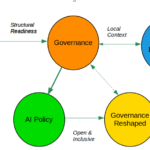The idea of innovation, which is certainly not new to development practitioners, is again picking up steam. In fact, it has become a buzzword that is permeating many discussions and conversations on development and beyond.
The Arab Spring and the many other new social movements in both the developed and developing countries have brought back to the forefront not just the catalytic importance of new ICTs but also, and perhaps more importantly, the centrality of democratic governance in fostering sustainable human development. Now more than ever before, and in times of social and economic crisis in many countries, we need to strengthen (and in some cases build) the bridges between public institutions and the people where the latter have a voice that counts, is heard by the former, and the former is capable of responding effectively and transparently.
Nowadays, what is perhaps really new is the more vital link between innovation and democratic governance.
For many, innovation seems to be driven by technology or ICTs alone. While this might be the case in some instances in the development field – remember the Green Revolution? – this is not always true. From a development perspective, the critical issue is the diffusion of innovations, that is, the uptake by final beneficiaries of the new solutions furnished by development practitioners, the private sector, etc. There is already a vast development literature on this topic, which seems to be behind the back burner of most ongoing discussions and implementation programs.
Today, we also hear quite a bit about social innovation, an idea that has existed in various incarnations since the 1860s or so.
In any case, what is really different today?
While in the recent past, innovation was usually associated with “stuff” happening in industrialized countries, today, we are seeing a shift towards developing countries for the first time in centuries. In other words, innovation is now taking place on a larger scale in countries that traditionally were not known for being part of the innovation circles. India is one example. Kenya is another. And there are many others. A vital aspect of the new innovation wave in the South is that it is directly linked to development agendas and targets. That is to say, there is now a concerted effort to address critical socio-economic and governance gaps with new solutions and tools generated inside countries facing such gaps. Here, social innovators play a crucial role.
The rapid evolution of mobile technologies has provided fertile ground for this new innovation trend. By the end of 2012, it was estimated that almost 5 billion mobile phone subscribers lived in developing countries—and this number is growing. The same data indicates that Asia and Africa are the fastest-growing regions in this regard. Although these numbers are impressive, let us not lose sight of what is happening behind the scenes.
Why is this so? First, the barriers to entry for the production, distribution and consumption of new tools and solutions have been dramatically reduced in the last 5 to 7 years. Second, many innovative solutions developed countries provide do not reach the bottom of the pyramid, nor are they designed for such purpose. There is a latent demand, a captive market for affordable and “pro-poor” innovative solutions that can rapidly diffuse if price points and needs are satisfied. Third, the new technologies are also interactive communication tools that, in principle, give voice to those who have none before – so here we have, simultaneously, a governance innovation.
Kenya is an excellent example of an innovative economy in a developing country. Well known for crowdsourcing with Ushahidi and mobile money with M-Pesa, to mention just a couple, this economy emerged recently in response to specific socio-economic and political issues. Kenya is also doing new stuff on health, agriculture, education, etc., supported by local social entrepreneurs, with women being part and parcel of this process. Indeed, a culture of innovation has flourished in the country. The same is happening in several other developing countries.
In these cases, social innovation is happening on a bottom-up basis. Local community members with adequate skills get directly involved in addressing specific issues that the community confronts. Many of them are, in turn, members of such communities and thus have the trust of local stakeholders. On the other hand, governments are still marginally involved or have yet to embrace these efforts. Being that as it may, the critical issue here is that the sustainability of most of these efforts is embedded within, as the communities themselves are integral parts of the process.
However, issues of replicability and scalability remain to be addressed for most of these initiatives. This is where the government can play a catalytic role in supporting and piggybacking on these efforts by building strategic multi-stakeholder partnerships—thus also innovating in this area and moving beyond traditional public-private partnerships.
On the governance side, the new solutions and tools promote three key principles: participation, transparency and accountability, which are today the pillars of Open Government. These require the involvement of governments and stakeholders of all sectors, who, working together as partners, can effectively strengthen the public sphere and thus enhance democratic governance in developing countries in the medium and long term.
Cheers, Raúl





